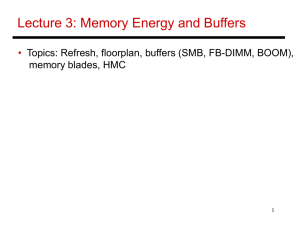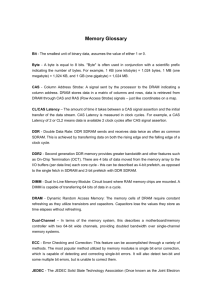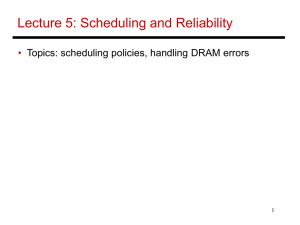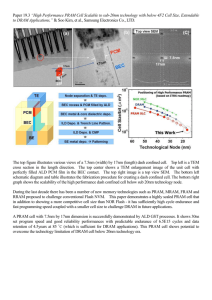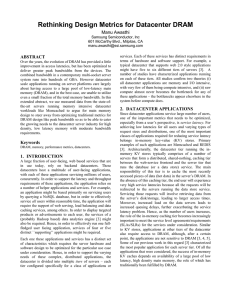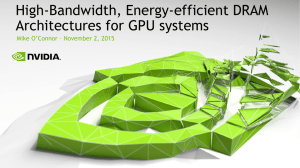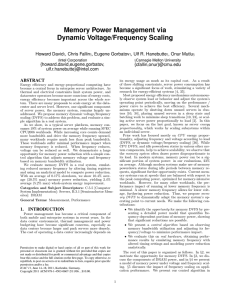Heterogeneous Memory & Its Impact on Rack
advertisement
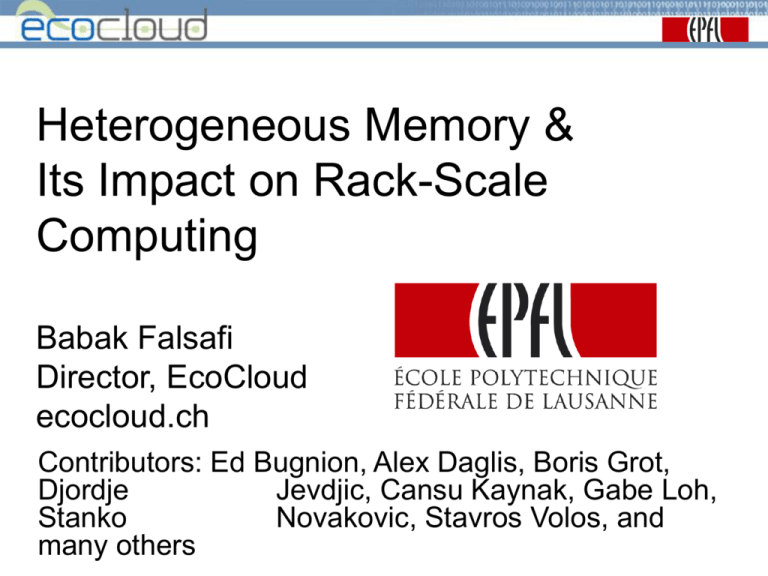
Heterogeneous Memory & Its Impact on Rack-Scale Computing Babak Falsafi Director, EcoCloud ecocloud.ch Contributors: Ed Bugnion, Alex Daglis, Boris Grot, Djordje Jevdjic, Cansu Kaynak, Gabe Loh, Stanko Novakovic, Stavros Volos, and many others Three Trends in Data-Centric IT 1. Data – – Data grows faster than 10x/year Memory is taking center stage in design 2. Energy – – Logic density continues to increase But, Silicon efficiency has slowed down/will stop 1. Memory is becoming heterogeneous – – DRAM capacity scaling slower than logic DDR bandwidth is a showstopper What does this all mean for servers? Inflection Point #1: Data Growth • Data growth (by 2015) = 100x in ten years [IDC 2012] – Population growth = 10% in ten years • Monetizing data for commerce, health, science, services, …. Data-Centric IT Growing Fast Source: James Hamilton, 2012 BC 332. Daily IT growth in 2012 = IT first five years of business! Inflection Point #2: So Long “Free” Energy Robert H. Dennard, picture from Wikipedia Dennard et. al., 1974 Four decades of Dennard Scaling (1970~2005): • P = C V2 f • More transistors • Lower voltages ➜ Constant power/chip End of Dennard Scaling Power Supply Vdd 1.2 Today 1 0.8 Projections 0.6 2001 Slope = .014 0.4 2013 Today 0.2 Slope = .053 0 2001 2006 2011 2016 [source: ITRS] 2021 2026 The fundamental energy silver bullet is – Prius instead of race car • Restructure software Modern Multicore CPU (e.g., Tilera) With voltages leveling: • Parallelism has emerged as the only silver bullet • Use simpler cores Conventional Server CPU (e.g., Intel) The Rise of Parallelism to Save the Day Multicore Scaling 7 The Rise of Dark Silicon: End of Multicore Scaling 1024 Even in servers with abundant parallelism 512 Number of Cores But parallelism can not offset leveling voltages Dark Silicon 256 128 64 32 16 8 Max EMB Cores Embedded (EMB) General-Purpose (GPP) 4 2 Core complexity has leveled too! Soon, cannot power all 1 2004 2007 2010 2013 2016 2019 Year of Technology Introduction Hardavellas et. al., “Toward Dark Silicon in Servers”, IEEE Micro, 2011 Billion Kilowatt hour/year Higher Demand + Lower Efficiency: Datacenter Energy Not Sustainable! 280 240 200 160 120 80 40 0 A Modern Datacenter Datacenter Electricity Demands In the US (source: Energy Star) 50 million homes 2001 2005 2009 2013 2017 17x football stadium, $3 billion • Modern datacenters 20 MW! • In modern world, 6% of all electricity, growing at Inflection Point #3: Memory [source: Lim, ISCA’09] DRAM/core capacity lagging! 10 Inflection Point #3: Memory [source: Hardavellas, IEEE Micro’11] Scaling Factor 16 8 Transistor Scaling (Moore's Law) 4 Pin Bandwidth 2 1 2004 2007 2010 2013 2016 2019 Year DDR bandwidth can not keep up! 11 Online Services are All About Memory Vast data sharded across servers – Necessary for performance – Major TCO burden Core Core Core Core Core Core $ Network Memory-resident workloads Put memory at the center – Design system around memory – Optimize for data services Data Memory Server design entirely driven by DRAM! Our Vision: Memory-Centric Systems memory-centric systems Design Servers with Memory Ground Up! 13 Memory System Requirements Want • High capacity: Workloads operate on massive datasets • High bandwidth: Well-designed CPUs are bwconstrained But, must also keep • Low latency: on critical path of data structure traversals • Low power: memory’s energy a big fraction of TCO 14 Many Dataset Accesses are highly Skewed Access Probability 10 0 10 -1 90% of dataset accounts for only 30% of traffic 10 -2 10 -3 10 -4 10 -5 10 0 10 1 10 2 10 3 10 4 What are the implications on memory traffic? 15 Page Fault Rate Implications on Memory System H O T C O L D 25 GB Capacity/bandwidthCapacity trade off highly skewed! 256 GB 16 Emerging DRAM: Die-Stacked Caches Die-stacked or 3D DRAM • Through-Silicon Vias • High on-chip BW • Lower access latency • Energy-efficient interfaces DRAM Two ways to stack: 1. 100’s MB with full-blown logic (e.g., CPU, GPU, SoC) 2. A few GB with a lean logic layer (e.g., Individual stacks are limited in capacity! accelerators) 17 Example Design: Unison Cache [ISCA’13, Micro’14] • 256MB stacked on server processor • Page-based cache + embedded tags • Footprint predictor [Somogyi, ISCA’06] Optimal in latency, hit rate & b/w Core Core Core Core Core Core Core Core Core Core Core Core Core Core Core Core Core Core Core Core Core Core Core Core DRAM Cache CPU LOGIC Off-chip memory 18 Example Design: In-Memory DB • • • Much deeper DRAM stacks (~4GB) Thin layer of logic E.g., DBMS ops: scan, index, join Minimizes data movement, maximizes parallelism DB Request/ Response DRAM DRAM DRAM DRAM CPU DB Operators 19 Conventional DRAM: DDR CPU-DRAM interface: Parallel DDR bus • Require large number of pins So-called “Bandwidth Wall” • Poor signal integrity • More memory modules for higher capacity – Interface sharing hurts bandwidth, latency and power efficiency DDR bus CPU ~ 10’s GB/s per channel High capacity but low bandwidth 20 Emerging DRAM: SerDes Serial link across DRAM stacks Much higher bandwidth than conventional DDR Point-to-point network for higher capacity - But, high static power due to serial links - Longer chains higher latency Cache CPU SerDes links Must trade off bandwidth and capacity for power! 4x bandwidth/channel 21 Scaling Bandwidth with Emerging DRAM Emerging DRAMDRAM SerDes-connected 300 Memory power (W) Conventional DRAM DDR-connected DRAM matches BW x high static power 200 x low bandwidth low static power 100 2015 2018 2021 0 0 200 400 600 Memory bandwidth (GB/s) 800 1000 22 Servers with Heterogeneous Memory Emerging DRAM Conventional DRAM DDR bus Serial links Cache CPU H O T C C O LL D D 23 Power, Bandwidth & Capacity Scaling SerDes-connected Emerging DRAMDRAM Memory power (W) 300 DDR-connected DRAM Conventional DRAM MeSSOS Heterogeneo 200 us 2.5x higher server throughput 100 4x more energy-efficient 1.4x higher server throughput 0 0 200 400 600 Memory bandwidth (GB/s) 800 1000 HMC’s much better suited as caches than main memory! 24 Server benchmarking with CloudSuite 2.0 (parsa.epfl.ch/cloudsuite) Data Analytics Machine learning Data Caching Memcached Graph Analytics TunkRank Media Streaming Apple Quicktime Server Web Search Apache Nutch Data Serving Cassandra NoSQL SW Testing as a Service Symbolic constraint solver Web Serving Nginx, PHP server In Use by AMD, Cavium, Huawei, HP, Intel, Google…. Specialized CPU for in-memory workloads: Scale-Out Processors [ISCA’13,ISCA’12,Micro’12] 64-bit ARM out-of-order cores: • Right level of MLP • Specialized cores = not wimpy! System-on-Chip: • On-chip SRAM sized for code • Network optimized to fetch code • Cache-coherent hierarchy • Die-stacked DRAM Results • 10x performance/TCO • Runs Linux LAMP stack 1st Scale-Out Processor: Cavium ThunderX 48-core 64-bit ARM SoC [based on “Clearing the Clouds”, ASPLOS’12] Instruction-path optimized with: • On-chip caches & network • Minimal LLC (to keep code) 27 Scale-Out NUMA: Rack-scale In-memory Computing [ASPLOS’14] core ... core core Coherence domain 1 NUMA fabric LLC Memory Controller Coherence domain 2 Remote MC N I 300ns round-trip latency to remote memory Rack-scale networking suffers from – Network interface on PCI + TCP/IP – Microseconds of roundtrip latency at best soNUMA: – SoC Integrated NI (no PCI) – Protected global memory read/write + lean network – 100s of nanosecond roundtrip latency Summary Three trends impacting servers: – Data growing at ~10x/year – Nearing end of Dennard & Multicore Scaling – DDR memory capacity & bandwidth lagging Future server design dominated by DRAM – Online services are in-memory – Memory is a big fraction of TCO – Design servers & services around memory – Die stacking is an excellent opportunity 29 Thank You! For more information please visit us at ecocloud.ch


